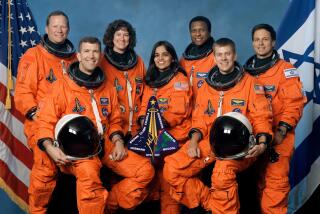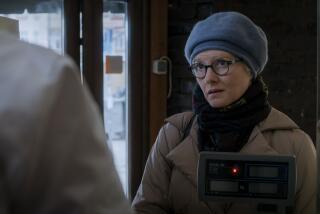Today’s lesson from space: Weightlessness
- Share via
CAPE CANAVERAL, FLA. — Teacher-astronaut Barbara R. Morgan transformed the space shuttle and space station into a classroom Tuesday. It was her first education session from orbit, fulfilling the legacy of Christa McAuliffe with joy and also some sadness.
“I’ve thought about Christa and the Challenger crew just about every day since 20-plus years ago,” Morgan said in a series of interviews right before class got under way. “I hope that they know that they are here with us in our hearts.”
Morgan, 55, who was McAuliffe’s backup for the doomed 1986 flight, got her first opportunity to talk with schoolchildren late Tuesday afternoon, almost halfway through her two-week mission.
Hundreds of youngsters jammed the Discovery Center of Idaho in Boise, less than 100 miles from the elementary school where Morgan taught before becoming an astronaut. Her two sons, now teenagers, attended inventors’ camp there.
One child wanted to know about exercising in space. In response, Morgan lifted the two large men floating alongside her, one in each hand, and pretended to be straining. Another youngster wanted to see a demonstration of drinking in space. Morgan and her colleagues obliged by squeezing red blobs from a straw in a drink pouch and swallowing them as they floated around. The four astronauts also used ping-pong balls and a softball for props.
Morgan was asked how being a teacher compared to being an astronaut.
“Astronauts and teachers actually do the same thing,” she answered. “We explore, we discover, and we share. And the great thing about being a teacher is you get to do that with students, and the great thing about being an astronaut is you get to do it in space, and those are absolutely wonderful jobs.”
The 25-minute question-and-answer session was a welcome diversion for NASA, which found itself trying to explain -- again -- why foam insulation is still falling off shuttle fuel tanks more than four years after the Columbia disaster.
The gouge in shuttle Endeavour’s belly apparently was not considered a threat to the crew, but NASA debated whether to send astronauts out to fix it to avoid time-consuming post-flight repairs.
So far, NASA’s thermal analyses makes everyone “cautiously optimistic” that no repairs will be needed, said John Shannon, chairman of the mission management team. All the testing and analyses should be completed by today.
“My understanding is that it’s really not a safety issue for us on board,” said Endeavour’s commander, Scott Kelly. “There isn’t a whole lot of concern on board right now.”
Indeed, business went on as usual aboard the joined shuttle-station complex Tuesday. Morgan and her colleagues removed a platform from Endeavour’s payload bay and attached it to the International Space Station, where it will be used to hold large spare parts.
A special team of astronauts and specialists spent a second day Tuesday mapping out what would be the best way to proceed, if repairs were ordered. Most likely, two astronauts would be maneuvered on the end of Endeavour’s 100-foot robot arm and extension boom to the difficult-to-reach spot, and would apply a black paint and caulk-like goo to the damage.
Any repairs would be done during the shuttle’s fourth spacewalk, set for Friday. If more time is needed to get ready, NASA will keep the shuttle at the station and bump the spacewalk to Saturday.
More to Read
Sign up for Essential California
The most important California stories and recommendations in your inbox every morning.
You may occasionally receive promotional content from the Los Angeles Times.










